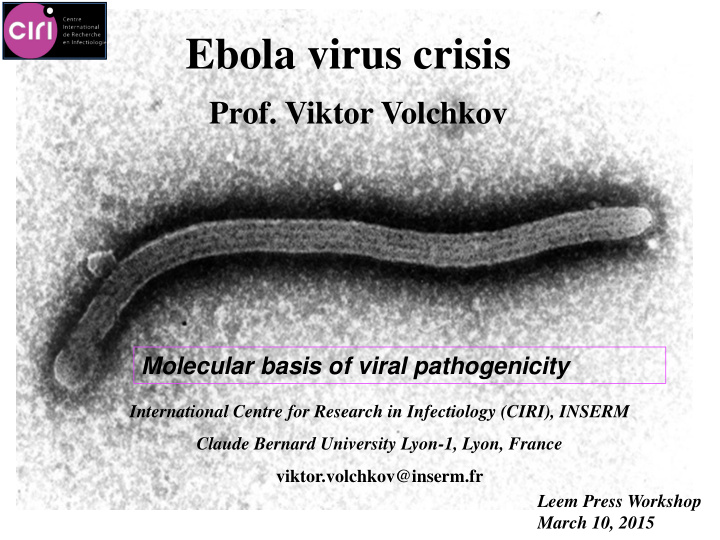



Ebola virus crisis Prof. Viktor Volchkov Molecular basis of viral pathogenicity International Centre for Research in Infectiology (CIRI), INSERM Claude Bernard University Lyon-1, Lyon, France viktor.volchkov@inserm.fr Leem Press Workshop March 10, 2015
Jean Mérieux INSERM BSL 4 Laboratory
The molecular basis of high pathogenicity Emergency of highly pathogenic viruses Lessons from current Ebola crisis
BSL P4 viral agents Ebola and Marburg viruses / Filoviridae Nipah virus / Henipaviridae Crimean-Congo hemorrhagic fever virus / Bunyaviridae
BSL P4 viral agents Infections kill up to 60-90% of patients Spread through human-to-human or animal-to-human contacts Intercontinental virus transfer / Potential bio-terrorism agent Currently no vaccines or treatments are available for human use Molecular bases of high pathogenicity are not well understood
Ebola virus 3 ’ 5’ NP 35 40 GP 30 24 L Enveloped, non-segmented negative-stranded RNA containing virus 7 structural proteins and 3 non-structural soluble proteins Surface glycoprotein: GP membrane Matrix protein VP40 VP24 Genomic RNA . Nucleoprotein(NP) . VP35 . VP30 . Polymerase (L)
Massive virus replication
“Masking” phenomenon/ GP gene editing and virus adaptation Reynard et al., J Virol 2009; Volchkova et al., JID 2011 EBOV and MARV Role of EBOV GP shedding GP/shedGP Esqudero-Perez et al., Plos Pathogenes 2014 VP35 and VP24 are IFN antagonists VP35/VP24 Prins et al., J Virol 2010; Mateo et al., J Virol 2010 . Innate Immune responses Molecular determinants of virulence Mateo et al., JID 2011 Inflammation Disregulation of host inflammatory responses VP24 Leung et al., JID 2011; Page et al., Cell Reports 2014 Oxidative stress Molecular switch: RNA replication versus transcription VP30/VP24 Martinez et al., J Virol 2010, JID 2011 RNA Synthesis/Virus assembly Role of VP24 in viral nucleocapsids assembly Mateo et al., JID 2011 High pathogenicity
Introduction Shedding of EBOV surface glycoprotein GP Shed GP Membrane GP Block virus neutralizing antibodies sGP Shed GP EBOV virion EBOV-infected cell
Shed GP of Ebola virus Triggers Systemic Immune Results Activation and Increased Vascular Permeability TLR-4 Non-infected cells EBOV Transcriptional activation and EBOV-infected TNF- α release of cytokines cell IL-6 IL-12 Shed IL-10 etc. GP Blood cells / fluid B/T Hepatocyte, DC/MØ Endothelial cells lymphocytes renal cells, etc Imballance Activati Organ failure Increase of permeability d on PLOS Pathogens, 2014 inflammation
Factors that contribute to high pathogenicity High efficiency of replication and viral pantropism Multiple antagonists of innate immunity Excessive and dysregulated host responses to viral replication « Loaded gun »
Virus – host interaction (I) Natural reservoir Low virus replication High level of virus adaptation Asymptomatic infection
Virus – host interaction (II) Accidental hosts High level of virus replication Low level of virus adaptation High pathogenicity
Virus emergence (I) Accidental hosts Natural reservoir
Virus emergence (II) Local infections Strict Quarantine End of outbreak Difficult to apply quarantine Virus spread Low Level Hospital Health Care Nosocomial infection
Lessons from current Ebola crisis: Always keep watching for known highly pathogenic viruses. Preparedness: Diagnosis Vaccine For all known highly pathogenic viruses. Therapeutics Exploring the link between Academic Science and Industrials. Keep moving forward. Learn more on molecular basis of high pathogenicity. Search for new, related viruses (African henipa- and filoviruses)
BACK UP
Research tools Reverse genetics approach T7 promoter Ribozyme NP 35 40 GP 30 24 L pFL-EBOV NP pFL-EBOV 1 NP T7 BSR T7/5 35 T7 35 cells 30 30 T7 1 T7 L L 5 6 NC genes mRNA`s L (T7 promoter) 2 30 4 3 35 Recombinant NP Ebola virus (cross section) Volchkov et al Science 2001 Ebola and Marburg viruses, Nipah virus and CCHF virus
Results EBOV mutant is completely attenuated α VP40 500 500 450 450 400 weight(g) D7 400 weight(g) WT 350 350 300 300 250 250 200 200 -5 -3 -1 1 3 5 7 9 11 13 15 17 19 21 23 25 27 29 -5 -3 -1 1 3 5 7 9 11 13 15 17 19 21 23 25 27 29 days post infection days post infection 600 D16 550 500 weight(g) 450 NE 400 350 300 D27 250 200 -5 -3 -1 1 3 5 7 9 11 13 15 17 19 21 23 25 27 29 days post infection JID, 2015
Recommend
More recommend